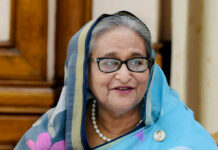Despite progress undernutrition costs Bangladesh over Tk7,000 crore a year
People in the country’s hilly areas and wetlands suffer from the highest level of undernutrition, according to data maps launched yesterday in the capital.
Children under five suffered most from hunger in Sylhet division where 51.3% of children suffered from stunting and 39.5% were underweight.
While Barisal and Khulna divisions had the lowest rates of stunting and underweight as well as the lowest share of the country’s total stunted children.
Undernutrition costs Bangladesh more than Tk7,000cr in lost productivity every year, according to a report.
The Bangladesh Bureau of Statistics (BBS), the International Fund for Agricultural Development (IFAD) and the World Food Programme (WFP) launched the first ever upazila level undernutrition maps of Bangladesh at the Bangabandhu International Conference Centre where state minister for finance and planning MA Mannan was present.
The maps were prepared on the basis of the Child and Mother Nutrition Survey 2012.
“Usually a lack of food security and awareness, and rising inflation causes the malnutrition problem in Bangladesh,” Dr Md Munirul Islam, a scientist with the Centre for Nutrition and Food Security at ICDDRB, told the Dhaka Tribune.
“But there are multifaceted causes of malnutrition,” the International Centre for Diarrhoeal Disease Research Bangladesh scientist said.
Undernutrition puts children at greater risk of dying from common infections, increases the frequency and severity of such infections, and contributes to delayed recovery, he said.
Six to eight hundred thousand Bangladeshi children are vulnerable to dying at any given time due to malnutrition, he added.
Any place that has a 15% undernutrition rate needs immediate intervention in line with international practices, Dr Md Munirul said.
Stunting rates are highest in Bandarban district of Chittagong division, a hilly area, followed by Cox’s Bazar district in the coastal belt of Chittagong division and Sunamganj district of Sylhet division which largely consists of haor [wetland] areas, the maps showed.
Stunting and underweight rates are lowest in Dhaka district, yet a large number of stunted children reside in the area as the total population of children under five years of age is high in the district.
In the hilly district of Bandardban, the stunting rate is very high, but the total number of stunted children is relatively small.
Thirty-nine out of 64 districts in Bangladesh have stunting rates above 40%, the World Health Organisation critical threshold level for stunting.
And 55 districts are above the WHO critical threshold level for underweight which is 30%.
At the upazila level, 300 out of 544 upazilas have a stunting rate above 40% while 440 upazilas have an underweight rate above 30%.
The upazilas surrounding the divisional cities of Dhaka, Chittagong, Khulna and Rajshahi have the lowest rates of stunting in their respective divisions.
Within Dhaka district, which has the lowest stunting rate in Bangladesh, the stunting rates varies from as low as 28% in the Dakhshinkhan area to as high as 41% in the Keraniganj area.
“The map shows undernutrition or malnutrition rate is high in hilly or wetland terrains due to limited accessibility,” project director Dr Dipankar Roy said.
He said Bangladesh had achieved a millennium development goal (MDG) by reducing the undernutrition rate to 32%.
Least developed countries need to cut the undernutrition rate to 33% by 2015 to achieve the MDGs.
World Food Programme country representative Crista Radar said over the past two decades, Bangladesh has made impressive economic and social gains.
However, challenges remain
to keep undernutrition levels
below the WHO public health critical thresholds.
In the mid 1990s, the malnutrition rate was 70%. In 2011 this was down to 41%, which is a remarkable achievement, she said.
“But seven million children still suffer from stunting in Bangladesh,” she said.
As the causes of undernutrition are manifold, she said, so are the solutions. There is no one solution, but the solutions are multi-sectoral.
Source: Dhaka Tribune










